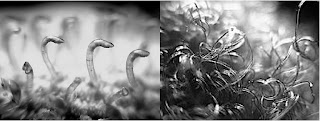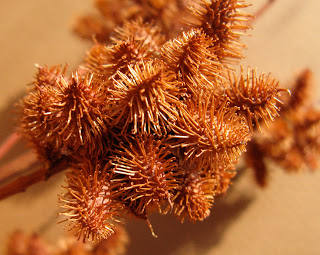Your children are not your children.
They are the sons and daughters of Life's longing for itself ...
You are the bows from which your children as living arrows are sent forth.
Kahlil Gibran, The Prophet
Do you remember leaving home? I do -- like many teenagers, I could hardly wait and I seized upon Gibran’s words when I read them. Now years later they still make sense to me, though they seem a bit maudlin. But the feelings of a parent (which I am not) are very different ... a human parent, that is. Isn't it interesting that many humans have a hard time letting their children go, while most animals and plants take the opposite approach -- rebuffing, excluding and even hurling their progeny into the unknown.
Plants will go to great lengths to send their propagules packing. Some seeds simply fall to the ground and never go much further, but many are dispersed far and wide. Most end up in inhospitable places with their mission unfulfilled, but some will colonize new sites and even expand the range of the species.
Wind and water are common means of scattering seeds, and plants have many adaptations for these vectors. Among the more familiar are the plumose seed tails of dandelions (above, courtesy The Guardian) and the buoyant outer coat of the coconut (below).
To right, Sparky participates in epizoochory (click to view).
The burrs that Sparky brought home are from our wild licorice, Glycyrrhiza lepidota. The name of the genus comes from the Greek glykys -- sweet -- and rhiza -- root. Roots of most species of Glycyrrhiza contain glycyrrhizic acid, the active ingredient of the sweet distinctively-flavored extract used in tobacco products, pharmaceuticals (to mask bitterness), beverages (foaming agent) and of course candy, although many “licorice” candies now contain anise instead.
 Commercial licorice products come from the cultivated licorice, Glycyrrhiza glabra, but the root of our wild licorice was once a source of sweetener as well, for Native Americans and early settlers in the western United States. Today, wild licorice root is used in herbal and homeopathic remedies (here for example). Glycyrrhizic acid is known to have beneficial medicinal effects, mainly in diseases related to cortisol regulation, and the biochemical pathways and physiological mechanisms have been elucidated. However it is dangerous in large dosages, causing hypertension and even death. Dalton (2002) provides a succinct overview of the benefits and dangers of glycyrrhizic acid.
Commercial licorice products come from the cultivated licorice, Glycyrrhiza glabra, but the root of our wild licorice was once a source of sweetener as well, for Native Americans and early settlers in the western United States. Today, wild licorice root is used in herbal and homeopathic remedies (here for example). Glycyrrhizic acid is known to have beneficial medicinal effects, mainly in diseases related to cortisol regulation, and the biochemical pathways and physiological mechanisms have been elucidated. However it is dangerous in large dosages, causing hypertension and even death. Dalton (2002) provides a succinct overview of the benefits and dangers of glycyrrhizic acid.
The flowers of the wild licorice are like most pea flowers, with characteristic petals -- a banner, two wings and a keel (photo above from CalPhotos; illustration to right from Montana Plant Life). And like all members of the pea family, its fruit is a legume. But what legumes! ... not exactly something you would put in the soup pot.
Adhesion mechanisms for epizoochory include sticky mucus and, more commonly, structures such as barbs and hooks. The hooks on the burrs of burdock (Arctium spp., photo to left) were the inspiration for Velcro. In 1948, Georges de Mestral, a Swiss electrical engineer, was pulling burrs from his dog’s fur after a day of hunting, and became curious as to what gave them their adhesive power. A look under the microscope revealed a fearsome array of hooks, prompting de Mestral to wonder if something similar could be constructed for use as a reversible fastener. By 1951 he had a working product, the first patent was granted in 1955, and after additional refinement, Velcro was introduced commercially in the late 1950s. Though slow to be accepted initially, it eventually became so popular that the registered trademark “Velcro” is now a generic term for hook-and-loop fasteners around the world. The interesting story of the “zipperless zipper” can be found here.
 |
| Velcro up close -- hooks on left, loops on right. |
 Commercial licorice products come from the cultivated licorice, Glycyrrhiza glabra, but the root of our wild licorice was once a source of sweetener as well, for Native Americans and early settlers in the western United States. Today, wild licorice root is used in herbal and homeopathic remedies (here for example). Glycyrrhizic acid is known to have beneficial medicinal effects, mainly in diseases related to cortisol regulation, and the biochemical pathways and physiological mechanisms have been elucidated. However it is dangerous in large dosages, causing hypertension and even death. Dalton (2002) provides a succinct overview of the benefits and dangers of glycyrrhizic acid.
Commercial licorice products come from the cultivated licorice, Glycyrrhiza glabra, but the root of our wild licorice was once a source of sweetener as well, for Native Americans and early settlers in the western United States. Today, wild licorice root is used in herbal and homeopathic remedies (here for example). Glycyrrhizic acid is known to have beneficial medicinal effects, mainly in diseases related to cortisol regulation, and the biochemical pathways and physiological mechanisms have been elucidated. However it is dangerous in large dosages, causing hypertension and even death. Dalton (2002) provides a succinct overview of the benefits and dangers of glycyrrhizic acid. |
| Glycyrrhiza lepidota, wild licorice (click to view). |
Wild licorice (also called American licorice) is native to and widespread in North America, growing in many different habitats. It is a robust perennial herb that can reach four feet in height. The underground part of the plant is robust as well, consisting of an extensive network of rhizomes and fleshy roots that produce adventitious shoots; thus wild licorice is rarely found as a single above-ground plant, but rather as large colonies. It is excellent browse for both wildlife and cattle (USDA NRCS), and yet is classified as a weed in many US states, for example Wyoming, North Dakota, Missouri and Nevada, probably due to its ability to persist and expand with disturbance. The burrs are more clearly a hazard for sheep ranchers, causing dockage if present in wool.
 |
| Single wild licorice leaf with leaflets pinnately arranged. |
Wild licorice is a member of the pea family (Fabaceae), and like many peas, its leaves are pinnately compound, i.e. subdivided into leaflets arranged along the axis of the leaf. Look closely at the photo below and you can see that the leaves are glandular punctate, with tiny round resinous glands.
 |
| Close-up of wild licorice leaf; from Matt Lavin’s Flickr site devoted to the plant diversity of sagebrush steppes. Click to view glands. |
 |
| Legumes (fruit) of wild licorice -- also known as burrs. |
By fall, the pretty flowers of the wild licorice are gone and the leaves have withered and died, leaving only standing dead stalks topped with menacing legumes. The wise walker with a dog avoids wild licorice patches this time of year. The tiny hooks are very tough, and sometimes burrs can be removed only with scissors.
With time the tissues soften, and by late winter it’s fairly easy to pull licorice burrs from dog fur. By late spring, when the first new green growth is appearing, the previous year’s fruit are gone -- dispersed to parts unknown, and it is again safe to walk the river trails.
Sources (in addition to links in text above)
Dalton, L. 2002. What’s that stuff? Licorice. Chemical & Engineering News 80: 37.
Sorenson, A.E. (1986) Seed dispersal by adhesion. Annual Review of Ecology and Systematics. 17: 443-463.
USDA Forest Service Fire Effects Information System -- Glycyrrhiza lepidota. Accessed February 2012.
USDA PLANTS Database -- Glycyrrhiza lepidota. Accessed February 2012.
USDA National Resources Conservation Service. Plant Fact Sheet for Glycyrrhiza lepidota. Accessed February 2012. http://plants.usda.gov/factsheet/pdf/fs_glle3.pdf









thank you, Hollis: great post, great pictures, and the quote from Gibran was the icing on the cake! :)
ReplyDeletethank you!
Delete